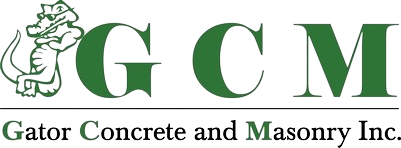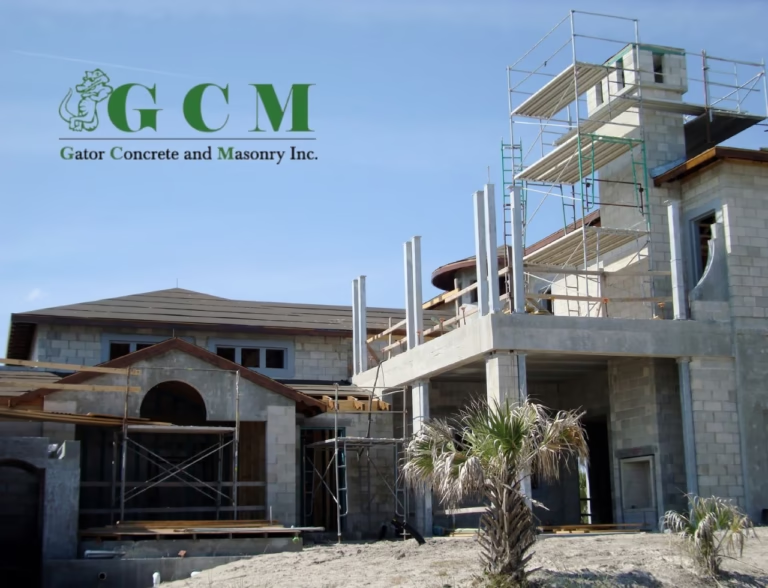The Reality of Concrete Work in Florida Summers
Florida summers are synonymous with extreme heat, high humidity, and sudden afternoon storms. These conditions create a uniquely difficult environment for contractors, particularly those working with concrete. The process of curing concrete—a critical step in achieving long-term durability and structural strength—is significantly affected by the environment in which it’s done.
When temperatures soar and moisture evaporates too quickly, concrete can cure unevenly or prematurely. This often results in surface cracking, reduced strength, and poor finish quality. At Gator Concrete and Masonry Inc., we’ve spent over two decades overcoming these challenges on job sites across the state. In this guide, we’ll share proven cooling techniques and expert strategies for managing summer heat & concrete curing effectively during Florida’s most demanding months.
The Science Behind Concrete Curing
Curing is the process that allows concrete to develop its full strength and durability by maintaining appropriate moisture and temperature conditions after placement. It’s not just about “drying”—it’s about hydration.
Understanding Hydration
When water reacts with cement in the mix, it forms calcium silicate hydrate—a crystalline structure responsible for the concrete’s strength. This reaction is highly sensitive to moisture and temperature levels. Too much heat can accelerate evaporation, shortening the working time and impairing the development of a strong internal structure.
Ideal Curing Conditions
- Temperature Range: 50°F to 75°F (10°C to 24°C)
- Humidity: Relative humidity above 80% is preferable for curing
When concrete cures in temperatures exceeding 90°F, without proper moisture retention, the risks increase dramatically. These include:
- Shrinkage cracking
- Surface dusting
- Incomplete hydration
- Long-term durability issues
Florida’s Climate: Why Special Attention Is Necessary
Florida’s weather is not only hot—it’s highly unpredictable. A typical summer day can include:
- Morning humidity levels over 90%
- Midday temperatures exceeding 95°F
- Afternoon thunderstorms with little warning
- High UV exposure and heat-retaining surfaces
This combination presents the perfect storm of complications for curing concrete. Materials arrive on-site hot. Forms and reinforcement are already retaining heat. If placement occurs during peak daylight hours, rapid surface drying can lead to cracking before finishing is complete.
Such conditions require strategic planning, proactive measures, and continuous monitoring.
Effective Cooling Techniques for Concrete in Hot Weather
At Gator Concrete and Masonry Inc., we’ve refined our processes to accommodate Florida’s summer extremes. Below are the most effective strategies we employ on-site:
Time Placement Strategically
- Early Mornings or Late Afternoons: These periods offer lower ambient temperatures and reduced direct sunlight.
- Avoid Peak Hours (11 AM – 4 PM): This is when UV exposure and surface heat are at their highest.
- Monitor Weather Forecasts: Avoid scheduling pours on days with predicted high temperatures or afternoon storms.
Pre-Cooling Concrete Materials
- Chilled Mixing Water: Reduces the temperature of the batch without affecting water-cement ratios.
- Ice Chips: Commonly used in the mix to lower internal temperatures.
- Cool Aggregates: Store sand and gravel in shaded areas or lightly spray with water before batching.
Employ Shading and Wind Control
- Use Temporary Shade Structures: Tarps, tents, or canopies over placement areas reduce direct sunlight exposure.
- Install Wind Breaks: Wind accelerates evaporation, which can be mitigated by setting up temporary barriers.
Maintain Surface Moisture
- Fogging or Misting Systems: Keep the surface hydrated during initial set without oversaturating.
- Wet Burlap and Curing Blankets: Help maintain consistent moisture and protect against surface cracking.
- Evaporation Retarders: These are spray-applied products that slow water loss during the finishing phase.
Add Chemical Admixtures
- Set Retarders: Extend the working time of the concrete by slowing down the hydration process.
- Air-Entrainment Admixtures: Improve durability and resistance to environmental stress, especially in exposed concrete.
Pre-Pour Preparation: Laying the Groundwork
Proper site preparation is essential before the first batch of concrete even arrives:
- Moisten the Subgrade: Dry soil can draw water from the concrete, weakening the mix.
- Cool Forms and Rebar: Spraying forms and reinforcement with water before the pour reduces heat transfer.
- Limit Delay Times: Ensure trucks are not waiting in high heat before discharge. Coordinate logistics carefully.
Post-Pour Procedures: Protecting the Final Product
Concrete curing does not end once the surface is finished. Several best practices must continue to protect the integrity of the structure.
- Apply Continuous Moisture: Use misting systems or rewetting methods to maintain hydration.
- Monitor Surface Temperatures: Use infrared thermometers or temperature probes for quality control.
- Timing of Form Removal: Don’t strip forms too early. High temperatures reduce set time, but strength gain is slower if not cured properly.
- Guard Against Thermal Shock: Sudden rain on hot concrete can cause cracking. Always cover fresh concrete if storms are forecast.
Common Mistakes to Avoid During Summer Pours
In our years of experience, we’ve seen these errors cause major setbacks—each completely preventable:
- Pouring onto dry or overheated subgrade
- Skipping the curing compound application
- Overwatering mixes to reduce temperature (which weakens the final product)
- Rushing placement and finishing to avoid heat, compromising quality
Consequences of Improper Curing in Florida Heat
Neglecting best practices during high-temperature curing can lead to:
- Surface Weakness and Cracking
- Delamination and Scaling
- Shortened Lifespan of Structural Components
- Increased Maintenance Costs and Callbacks
For residential and commercial property owners, this can mean premature deterioration of slabs, sidewalks, driveways, and load-bearing walls. For contractors, it may mean warranty repairs and lost reputation.
Best Practices and Final Advice for Florida Contractors
If you’re working on concrete projects during Florida’s summer months, keep these professional tips in mind:
- Develop a Job-Specific Hot Weather Plan
- Train Your Team on Heat-Specific Techniques
- Invest in the Right Tools and Materials
- Don’t Prioritize Speed Over Quality
The goal should always be a high-performing, long-lasting structure—achieved safely, even under challenging environmental conditions.
Excellence in Concrete Curing Starts with Planning
Florida’s summer climate is not changing anytime soon, but the quality of your concrete work doesn’t have to suffer because of it. With proactive planning, proven cooling techniques, and expert supervision, successful curing during extreme heat is absolutely achievable.
At Gator Concrete and Masonry Inc., we’ve built our reputation by delivering reliable, structurally sound concrete solutions across Florida—rain or shine, heat or humidity. With over 20 years of hands-on experience, we understand exactly what it takes to cure concrete right, especially during the most extreme weather conditions.
Partner with Gator Concrete and Masonry Inc.
Whether you need help with:
Our expert crew is here to get the job done correctly and efficiently, regardless of the season.
Contact GCM today to schedule your next concrete project. Let our experience work for you—because when it comes to summer heat & concrete curing, you need a team you can trust.

